
Available now!
Curly Like Me, the off-the-grid, do-it yourself owner's manual for tightly curly hair, is ready for ordering. Grab your copy today!

Every purchase made from
this site (through Amazon)
helps support it — and it
doesn't cost you anything
extra.
|
|
|
I have found there are seven basic steps to follow to make our hair healthy and happy:
I explain each one, below. (There are also videos available for most of these steps.)
|
|
CLEANSE:
|
|
SHAMPOOING
|
The first step in making our hair happy is to clean it in some way (and you absolutely don't have to use shampoo. You can skip right to the rinsing step, below, for a no-poo or conditioner-wash routine).
The gentler we are with this step the better——especially if we are using shampoo. Never ever pile your hair on top of your head and grind the shampoo in. All it will do is mat your curls. They tangle enough as it is. Don’t give them a reason to mat.
Let the water run over your hair, keeping your hair smooth and calm. Squeeze the water in to make sure it is saturated before applying shampoo.
When shampooing, apply the shampoo to your fingertips and insert them under your hair. Rub the shampoo onto your scalp only. It is your scalp that needs the washing. Your ends will get cleansed from the run off of the shampoo, plus the rinsing step following.
When your scalp is lathered, rinse thoroughly, opening sections for the water to run through. Do not involve your ends in this procedure. This is between the scalp and the shampoo only.
Only shampoo once!
You can click on the link to see some of the shampoos I recommend.

|
|
RINSING
*cool trick for curls*
Once all the shampoo has been rinsed from your hair, there is this neat trick you can do to get the effect of shampooing twice, without drying out your hair. You can use your combing conditioner (see conditioning step, below) like a shampoo. This will help wash out any remaining particles from your hair, cleanse the ends, yet it will condition instead of stripping your hair. Since our hair is so curly, if it gets too dry, things cling to it. Rinsing with conditioner makes it slippery, so it will rinse easier.
Apply a generous handful of conditioner to your scalp. Squeeze it down to the ends. You can insert your fingers under your hair to rub your scalp if you feel it needs more cleansing. Once it is rubbed into your scalp and squeezed through your ends, rinse it out as you would do the shampoo, always keeping your ends hanging loose. The conditioner will do what the shampoo would have done, which is to grab dirt and hold onto it while it is rinsed away with the dirt. It just does it much better.
|

|
|
CONDITION:
|
(See the section on products for good conditioners to use on super-curly hair)
Once you have gently rinsed all the conditioner out of your hair, it is time for a very very crucial step in taking care of your curls. This is important. It is this step that will protect you from humidity and wind. It will help weigh down your curls and make them predictable. Combined with the sectioning step (it comes after the combing section), it will make all the difference in the world with your curls.
Loosely divide your hair in half.
Take a big handful of conditioner. Ignore what the bottle recommends. The recommendations are for wimpy hair. Your hair is not wimpy. Take the big handful of conditioner and squeeze it into one half of your hair. Not so much on the scalp, but concentrate on the rest of your hair.
Make sure you feel it gooing thickly through all your hair. When you squeeze a section of hair, you should feel the conditioner gushing out. If there is a matted spot, poke it through with your fingers.
When you finish squeezing conditioner through one side, take another palmful of conditioner. Now squish it through the other side of your hair. Make sure the other half of your hair is saturated as well.
Here is a good sampling of combing/leaving in conditioners I recommend: Combing Conditioners
|
|
*Very Important!*
Don't rinse your hair!
The conditioner staying in your hair is the key to having conditioned, manageable curls. This is one of the two most important tricks to having glossy, behaving curls.
Don't worry if it seems like too much. The excess will come out when you comb your hair in the next step.
|

|
*The best thing to use for combing your hair is a Denman type brush (you can click on the brush for more information. I use the "D4" version). It has lots of give, and it’s strong. In addition, it primes your curls perfectly for the next crucial step.***
As a heads-up, your hair will foam like it's rabid as you comb it. This is normal. By the time you finish combing and smoothing, the conditioner will have vanished. Take a section of your hair to be combed. Your hair needs to be soaking wet with water and conditioner when you comb for this to work.
When pulling apart your hair, gently hold the ends, and slide one section out of the other. This should be somewhat easy to do because you have all that conditioner in your hair (you can check out photos of how I separate my hair for combing on the Hair Rules page).
When you’ve isolated a section, pin back the rest of your hair. Start at the end of the section and comb out the tangles. Then move up to the next tangled spot in that section and comb it gently out of your hair. Then move up to the next tangle, until they are all taken out of that section. In the photo, I'm moving a tangle down my hair. Next, I comb out the ends before combing the tangle out of my hair. To keep from hurting:
To keep from tugging on your (or your child’s very curly hair), it's important how you hold the hair. When you hold a section as you comb it, pinch it between your scalp and where you are combing it. You may have to pinch tightly, but this blocks the pain of the pulling reaching your scalp. It’s easiest to do this between your thumb (that's how I'm holding my hair in the foamy photo, above, and the photo on the left, below). In really tangled spots, I'll twist my hair a couple times, then pinch it when combing (shown in the photo on the right)
 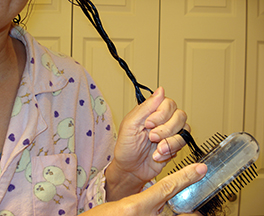
I first comb out my ends. Then I move the tangles out of my hair one by one, sort of like beads on a string. This shows my hair mostly combed, with a fat tangle waiting to be combed out of the ends.
This shows me at the last step combing the last tangle out of my ends.


|
|
DEFINE
*This is the next most important trick for manageable curls*
Once you have combed your hair, you need to define and reinforce your curls.
There are three main ways to define your curls: Running your fingers through, doodles, and smoothing each curl.
Running Your Fingers Through
I think this works best for wavier hair, or loose curls. When you run your fingers through your hair, run them through several times, in the direction your hair grows. You can even press your fingers together as you do it. This will give you some definition, but your curls may still be undefined. I can't do this very well with my hair because I can't get my fingers through my curls. I also think it yanks on the hair too much if you have tighter curls. l like lots of definition in my curls, and this doesn't define curls very well.
The next two ways of defining your curls takes advantage of it's desire to curl: Smoothing each curl and Doodles:
Smoothing each curl
When the area you are working on has been combed, you may notice that your hair will start to section itself into curls. You can see my hair dividing itself into two curls in the larger picture where I’m combing a small section with the blue Denman brush.
Your hair wants to clump. Curly hair wants to curl together with like curls. If you work with the natural tendency of your hair, you will make both you and your hair happy. By sectioning your hair, you reinforce your natural texture. Enhancing the curls in the way they want to be will keep it clumped together, and not frizz. And the conditioner in it will help keep it together without being crunchy.
Divide your section into however many curls it wants to be divided into. Wavier hair clumps in bigger sections. Tighter curls need much much smaller sections. If you have a section and it separates into more curls, you need to honor what your curls want, and section it until it is one solid unit. This may be different sizes on different parts of your head. For me, the back and by my ears can take pretty big clumps, while at the crown and back of my head need lots and lots of smaller sections, about 1/5 the size of other parts of my head.
Doodles
Another great way to define curls, especially if your hair is short, is by twirling your curls around your finger—my mom calls them " DOODLES" (you can click on the link for more information and photos about creating adorable doodles).
*For all three defining techniques, the trick is that the tighter your curls, the smaller the sections you take to take to twirl. This may mean making very small curls on some parts of your hair, and defining larger curls units in others (I have to do this).
Smoothing
This is how I define my curls. After combing with a Denman, you will often see your hair separating into segments.
I take each segment, and run my hands down it. This sets your curl by smoothing all the hairs together to act as a unit. The tighter the curl, the smaller the segment you smooth. Some places on your head may need lots of very tiny curls you smooth, and others larger. You can see in the photos of my wet hair that it's separating in all different sizes. Those are the sizes of the curls I smooth.
 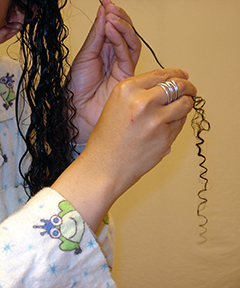 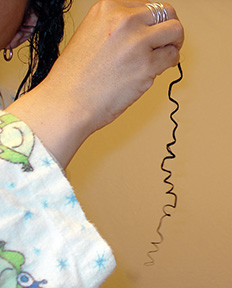
Smooth all the individual curls in the section, then pin them out of the way and move onto the next section.
How to Define Your Curls, The Video
It's best to define your curls when they are sopping wet, with tons of conditioner in them.
Just so you know:
If you usually brush or comb your hair every night, when you switch to using this technique, you will only brush it after washing and conditioning. Since you are brushing less often, but you are loosing the same amount of hair, there will be more hair left in your brush. You are shedding the same amount of hair, you will just be seeing it all at once, instead of a little at a time.
|

|
|
DRY
Once you have combed, sectioned, and smoothed all your hair, it is time to let it dry.
DON'T DO ANYTHING TO YOUR HAIR WHILE IT DRIES!
Just let it be.
Never brush or comb dry hair or drying hair. You will turn a curl into a cloud instantly (see rules for picture of what happens to to dry curls after combing).
Just so you know, your hair may look a bit stringy or a little crunchy when you're done. This is actually good, it means your curls have set. After you put up your hair at night, by morning your curls will be soft yet defined. For a video showing what my hair looks like right after combing it, before it dries (as well as the fuzzball from my brush, you can check out Just Finished Combing.
|

|
To keep your hair calm and protected while you sleep, it's good to put up your hair. At night simply put your hair in a bun or two, or a braid or two, depending on the length.
To keep your ends from tangling while you sleep:
Braid your hair to about three inches from the ends. Then combine two of the sections together so you are left with just two segments. Take these segments and twist to the ends. Take those ends, loop them into a "U", and tuck the ends into the rest of the braid. (Since my ends are so curly, they tangle up when I try to undo the ends of a braid. They are much easier to undo in the morning when I twist the last few inches of my braid).
 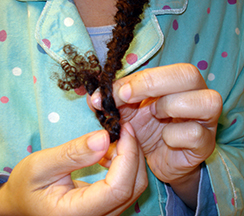 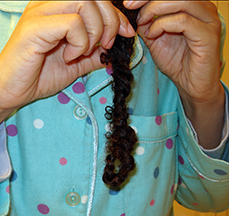
My hair is now braided and protected for sleeping.
|

|
Until you go to wash it again, your hair will be very easy to take care.
In the morning, all you have to do is unbraid it or unbun it, and smooth a little conditioner and water over your hair. Do not finger comb. Just smooth over it. Use a few passes with water and conditioner for fuzzy parts. Now your hair will be sweetly scented and smooth.
In the photos below, I'm smoothing my wet hands (that have a bit of combing conditioner rubbed between them) over the sides of my hair. I re-wet my hands, rub a bit more of the combing conditioner between my hands, and I smooth them over my ends. If I want my curls to curl up even tighter, but with definition, I repeat this several times.
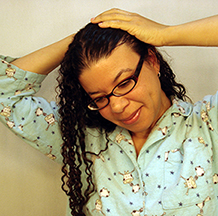 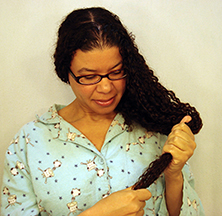
If you style it, it’s pre-divided for you. Just gather your curls in the desired style and style them. No more fighting to rip your hair apart to divide it.
|

|
|
DOODLES:
|
If you'd like to try Doodles, I've gathered some wonderful photos of doodles. Arden's mom is doing this to her hair in Tips for Little Ones(and both Mya and Frances have their curls done this way) in the Before and After page.
Ebony, the fierce winner of Going-Natural.com's Miss Nappturality contest, showcased stunning Doodles during Challenge 6.
First Ebony showed how she twirled her curls around her finger after putting in conditioner and combing it:

Then she showed her breathtaking doodles:

|
|
|

|
|
This is how long my hair has grown following these techniques:
|
|
|
|
|